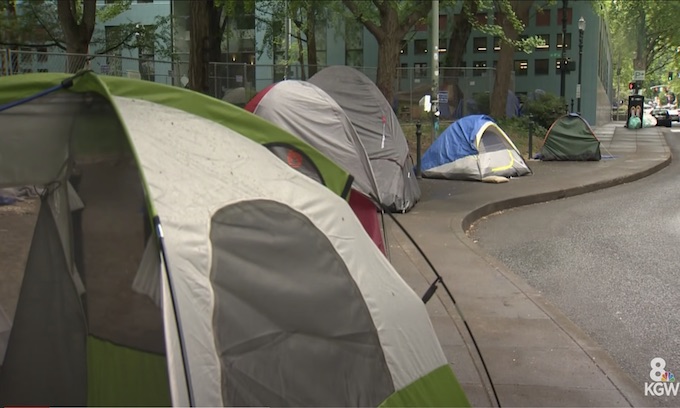After the financial collapse of a leading homeless housing provider in Los Angeles amid reports of unsafe living conditions, drug overdoses, and violence in its buildings, homeless advocates are questioning whether California’s “housing first” and “harm-reduction” approaches are alleviating or aggravating the intertwining crises of homelessness and drug addiction.
The Skid Row Housing Trust, a nonprofit providing nearly 2,000 units of permanent housing across 29 buildings, faced an annual budget deficit of $14 million. Through the city’s intervention, all those buildings were placed under a receivership by court order April 7 under Mark Adams, president of California Receivership Group, for repairs.
Under the receivership, Adams is responsible for repairing 500 units, per the legal requirement that property owners must address health or safety code violations. The California Receivership Group is an institution that takes over reparation and maintenance for “problem properties where traditional strategies have been unsuccessful,” according to its website.
The change came just two days after three individuals were found dead by a suspected drug overdose inside one of the trust’s buildings.
‘Housing First,’ ‘Harm Reduction’ Worsen Homelessness: Homeless Housing Providers
Some homeless housing providers in the city say changing the buildings’ management won’t help, mainly because the city hinges on a “harm reduction” model, which—instead of focusing on reducing drug use or eliminating addiction—is aimed at reducing overdose risk by providing naloxone, an opioid antidote, and a “safe” environment for the addicted to administer drugs.
In California, harm reduction is often coupled with the Housing First strategy—which prioritizes housing over substance abuse treatments and other mental rehabilitation—as the primary solution to homelessness, which was codified in the state law in 2016 through Senate Bill 1380.
Homeless housing and related services with such an approach recognize “drug and alcohol use and addiction as a part of tenants’ lives, where tenants are engaged in nonjudgmental communication regarding drug and alcohol use,” according to bill language (pdf). Therefore, tenants don’t have to maintain sobriety to qualify for long-term housing and will not be stopped from continuing drug use.
Rev. Andy Bales, CEO of the Union Rescue Mission—a faith-based nonprofit providing supportive housing to the homeless in Skid Row with wraparound treatment services—told The Epoch Times such an approach is destroying long-term homeless housing in Los Angeles, including the buildings formerly operated by the Skid Row Housing Trust.
“The harm reduction model should be described as a free flow of alcohol and hard drugs and intimidation from gangs, and it’s all backed by violence,” Bales said.
He said because “the gangs rule on Skid Row,” the lack of restrictions leads to chaos in the buildings.
But this model is now a nationwide movement and often includes needle exchange programs and the distribution of naloxone to reduce the risk of disease transmission through reusing contaminated needles and opioid overdose.
The National Harm Reduction Coalition—a New York-based nonprofit formed in 1993 calling for an end to “racialized drug policies” and an “ally for people who use drugs,” according to its website—runs several programs in Los Angeles County, including Skid Row, offering tips to “safely” consume illicit drugs like fentanyl.
“California is the only state that’s doubled down on this failed policy of housing first and harm reduction,” Bales said. “And it has increased street homelessness.”
He added his nonprofit does not receive public funding because it is “recovery-focused,” instead of primarily abiding by the harm reduction model.
Brian Ulf, president of the SHARE! Housing Board based in Los Angeles, told The Epoch Times the collaborative housing units he oversees have been successful in helping substance-abusing tenants make a full recovery.
The units operate under the Housing First policy and receive some public funding, but what sets them apart is the presence of social support workers and a set of guidelines that residents must follow, such as a curfew and a no-drug policy within housing units, to which Ulf attributes their success.
He said the Skid Row Housing Trust’s model failed because it “has no requirements [for tenants] to use any of its services.”
“You’re allowed to drink in your room, you’re allowed to do drugs in your room, you’re allowed to not take your bipolar medicine, you’re allowed to not be in any long-term treatment program,” he said.
“The Skid Row housing trust [had] all new buildings at one point, and had all brand new renovated bathrooms at one point,” he added. “But when you put all these people in the same room with no ability or desire to get help and add the drug dealers, they’re completely out of control.”
The Skid Row Housing Trust was not immediately available for comment by press deadline.
City News Service contributed to this report.



















How many MILLIONS have been thrown at the problem already, and all its done is make THINGS WORSE??
SO what makes them think throwing even MORE WILL DO a damn thing??
solution number one – get rid of all socialist demoncrats.
AND their voter base!